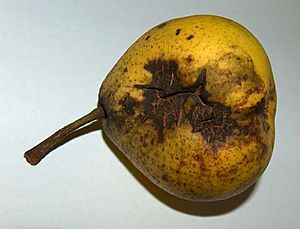Venturia pyrina facts for kids
Quick facts for kids Venturia pyrina |
|
|---|---|
 |
|
| Pear scab | |
| Scientific classification | |
| Genus: |
Venturia (fungus)
|
| Species: |
pyrina
|
| Synonyms | |
|
Endostigme pyrina (Aderh.) Syd. (1923) |
|
Venturia pyrina is a tiny fungus that causes a common plant disease called scab or black spot on pear trees. It's a type of plant pathogen, which means it's a living thing that can make plants sick. This fungus is found all over the world in places where pears grow, especially in temperate and subtropical areas.
Contents
What is Pear Scab?
Pear scab is a disease that affects pear trees. It is caused by the Venturia pyrina fungus. This disease can harm the leaves, branches, and especially the fruit of pear trees. It is a big problem for farmers who grow pears.
How Does Pear Scab Affect Pears?
When a pear tree gets scab, you might see dark, spotty areas. These spots can look like scabs, which is how the disease got its name. On the fruit, the spots are often black or brown. They can make the pears look ugly and sometimes cause them to crack. This makes the pears hard to sell or eat.
Symptoms on Leaves and Branches
The fungus also attacks the leaves of the pear tree. You might see small, dark spots on the leaves. If the infection is bad, the leaves might turn yellow and fall off early. On the branches, the fungus can cause small, raised spots. These spots can sometimes make the branches weak.
Life Cycle of Venturia pyrina
The Venturia pyrina fungus has a special way of growing and spreading. It spends part of its life cycle on fallen leaves during winter. Then, in spring, it releases tiny spores that float in the air. These spores are like tiny seeds that can start new infections.
How the Fungus Spreads
When the weather is wet and cool, the spores land on new pear leaves or young fruit. They then start to grow and cause new spots. The fungus can keep spreading throughout the growing season, especially if there is a lot of rain. This is why pear scab is more common in wet climates.
Managing Pear Scab
Farmers and gardeners try to control pear scab to protect their pear trees. One way is to clean up fallen leaves in the autumn. This helps remove the fungus before it can release spores in the spring.
Protecting Pear Trees
Sometimes, special sprays are used to protect the trees. These sprays help stop the fungus from growing. Growing types of pear trees that are naturally resistant to scab is another good way to fight the disease. This means choosing pear trees that don't get sick as easily.
Images for kids
See also
 In Spanish: Venturia pyrina para niños
In Spanish: Venturia pyrina para niños


